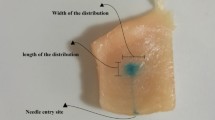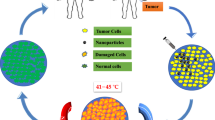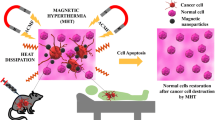Abstract
The large blood vessels surrounding the tumor would significantly result in heat sink, and thus seriously limit the thermal ablative area during tumor hyperthermia. Magnetic nanoparticle (MNP) was recently identified as an important heating enhancer to improve the treatment efficiency. It will not only help to absorb more energy under the irradiation of external magnetic field, but also can block the blood flow and subsequently weaken the heat sink effect of large vessels. In this study, these two critical factors, reserved to be undisclosed before in theory, were comprehensively investigated through three-dimensional numerical simulation. The results suggested that concerning the contribution to temperature increase in the tissues surrounding large vessel, the factor of blood flow blocking is more effective than that of energy absorption. Therefore, selective loading of MNPs to the target sites is expected to serve as a promising method to perform successful hyperthermia treatment for tumor tissues embedded with large blood vessels.













Similar content being viewed by others
References
Chen ZP, Roemer RB (1992) The effects of large blood vessels on temperature distributions during simulated hyperthermia. ASME J Biomech Eng 114:473–481
Chien S, Usami S, Taylor HM, Lundberg JL, Gregersen MI (1966) Effects of hematocrit and plasma proteins on human blood rheology at low shear rates. J Appl Physiol 2:81–87
Consiglieri L, Santos I, Haemmerich D (2003) Theoretical analysis of the heat convection coefficient in large vessels and the significance for thermal ablative therapies. Phys Med Biol 48:4125–4134
Crezee J, Lagendijk JJW (1992) Temperature uniformity during hypertherm: the impact of large vessels. Phys Med Biol 37:1321–1337
Deng ZS, Liu J (2004) Monte Carlo simulation of the effects of large blood vessels during hyperthermia. Lect Notes Comput Sci 3314:437–442
Deng ZS, Liu J (2007) Theoretical evaluation on the thermal effects of extracellular hyperthermia and intracellular hyperthermia. In: International conference on integration and commercialization of micro and nano-systems January 10–13, Sanya, China
Gijsen FJH, van de Vosse FN, Janssen JD (1999) The influence of the non-Newtonian properties of blood on the flow in large arteries: steady flow in a carotid bifurcation model. J Biomech 32:601–608
Giustini AJ, Ivkov R, Hoopes PJ (2011) Magnetic nanoparticle biodistribution following intratumoral administration. Nanotechnology 22:345101–345105
Hergt R, Dutz S, Muller R, Zeisberger M (2006) Magnetic particle hyperthermia: nanoparticle magnetism and materials development for cancer therapy. J Phys Condens Matter 18:S2919–S2934
Horng TL, Lin WL, Liauh CT, Shih TC (2007) Effects of pulsatile blood flow in large vessels on thermal dose distribution during thermal therapy. Med Phys 34:1312–1320
Kolios MC, Sherat MD, Hunt JW (1995) Large blood vessel cooling in heated tissues: a numerical study. Phys Med Biol 40:477–494
Kuznetsov AA, Filippov VI, Alyautdin RN, Torshina NL, Kuznetsov OA (2001) Application of magnetic liposomes for magnetically guided transport of muscle relaxants and anti-cancer photodynamic drugs. J Magn Magn Mater 225:95–100
Liu J, Deng ZS (2008) Physics of tumor hyperthermia. Science Press, Beijing
Rosensweig RE (2002) Heating magnetic fluid with alternating magnetic field. J Magn Magn Mater 252:370–374
Shih TC, Kou HS, Lin WL (2003) The impact of thermally significant blood vessels in perfused tumor tissue on thermal dose distributions during thermal therapies. Int Commun Heat Mass Transf 30:975–985
Van Leeuwen GMJ, Kotte ANTJ, Lagendijk JJW (1998) A flexible algorithm for construction of 3-D vessel networks for use in thermal modeling. IEEE Trans Biomed Eng 45:596–604
Wang HJ, Dai WZ, Bejan A (2007) Optimal temperature distribution in a 3D triple-layered skin structure embedded with artery and vein vasculature and induced by electromagnetic radiation. Int J Heat Mass Transf 50:1843–1854
Wang Q, Deng ZS, Liu J (2011) Effects of nonuniform tissue properties on temperature prediction in magnetic nanohyperthermia. ASME J Nanotechnol Eng Med 2:021012
Yanase M, Shinkai M, Honda H, Wakabayashi T, Yoshida J, Kobayashi T (1997) Intracellular hyperthermia for cancer using magnetite cationic liposomes: ex vivo study. Jpn J Cancer Res 88:630–632
Yanase M, Shinkai M, Honda H, Wakabayashi T, Yoshida J, Kobayashi T (1998) Intracellular hyperthermia for cancer using magnetite cationic liposomes: an in vivo study. Jpn J Cancer Res 89:463–469
Acknowledgments
This work is supported by the NSFC under Grant 81071255, the Specialized Research Fund for the Doctoral Program of Higher Education, and Research Fund from Tsinghua University under Grant 523003001.
Author information
Authors and Affiliations
Corresponding author
Rights and permissions
About this article
Cite this article
Wang, Q., Deng, Z.S. & Liu, J. Theoretical evaluations of magnetic nanoparticle-enhanced heating on tumor embedded with large blood vessels during hyperthermia. J Nanopart Res 14, 974 (2012). https://doi.org/10.1007/s11051-012-0974-6
Received:
Accepted:
Published:
DOI: https://doi.org/10.1007/s11051-012-0974-6




